Defense is still looking good right now…
The S&P 500 annualized a 6 1/2-year return of 13.7% through its summer highs. The recent uptick in volatility shows you that investors who were happy with the run are now interested in banking some of those gains. Even the 2nd largest pension fund, CalSTRS, is going to downshift their equity risk into less volatile buckets, and save money for a rainy day. The clouds continue to build and threaten in the form of Emerging Markets, widening Credit Spreads, Investor Fund flows, and Congressional spending disagreements. Also complicating things is the upcoming FOMC shift from Easing to Tightening. The market is betting on a delayed rate hike this week but it is going to start at some point. The Fed has made it clear that they are preparing for wage inflation, and that it would take more International pressures to keep them from tightening. While there are still some areas of the market to hunt in and be long, this is not a time to be all in on risk. Pick your spots prudently and wait for some clouds and volatility to dissipate.
So what data could the Fed be looking at to raise rates this week? David Rosenberg would highlight last week’s JOLTS data…
The ratio of the unemployed to the level of job openings has declined to 1.43x, far below the near-7x peak at the worst part of the Great Recession and a place we have been at just two other times before (since the JOLTS data were first published.) This may well be the most accurate measure of just how tight the labor market is — we are heading to an environment where we are down to one person competing for one job. The sands have shifted toward this being a sellers’ market for labor. Wage acceleration either starts real soon or we can simply take the laws of supply and demand and throw them in the dustbin.
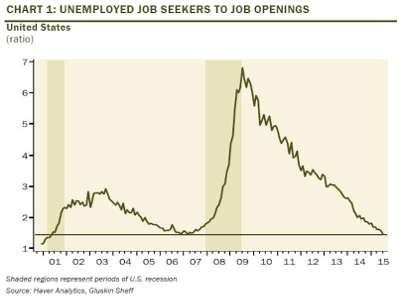
The Housing and Construction industry is having its own set of issues in finding workers…
While debate rages on about whether demand or supply factors are more to blame for the sluggish home-construction recovery, most industry observers and participants agree on at least one point: Construction labor is in short supply. Scant availability of skilled construction workers has hampered home construction at various times in the past few years of recovery. But the shortfall seems to have grown more acute of late, as new-home sales are up 21.2% so far this year from the same period last year and commercial construction has increased steadily. Construction employment isn’t quite keeping pace with that rebound, and workers with certain skills, such as carpenters and sheet-metal installers, are hard to find.
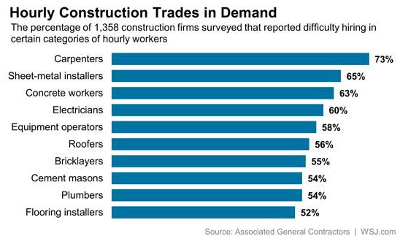
J.P. Morgan’s forecast and the University of Michigan survey of wage inflation are also moving up and to the right…
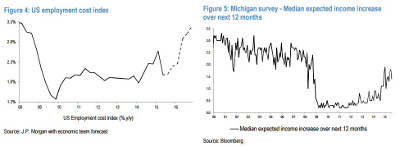
Meanwhile, the market is betting on higher short-term rates. Why wouldn’t the Fed use the implied market as an excuse to lift now and put a few rate cuts in its pocket for later?
@MktOutperform: 2-Yr Treasury yield at highest level since Apr ’11. Sep hike still a low prob (28%) but market saying it’s coming.

Many would argue that inflation is under pressure to the downside due to the big move in oil. Some big Banks took axes to their crude forecasts last week, including Credit Suisse…
@csapac: We’ve significantly lowered our Brent #oil forecast for 4Q15 to US$48 / barrel

And then Goldman Sachs (NYSE:GS) lowered its global crude oil price forecast last week…
the oil market is even more oversupplied than we had expected and we now forecast this surplus to persist in 2016 on further OPEC production growth, resilient non-OPEC supply and slowing demand growth, with risks skewed to even weaker demand given China’s slowdown and its negative EM feedback loop.

Of course, for the users of fuel (like Delta Airlines), plunging prices are going to be a bonanza for their shareholders, employee-owners, and customers…
Delta Air Lines (NYSE:DAL) said on Wednesday it expects to pay between 30 percent and 35 percent less for its fuel in the second half of the year than in the first.
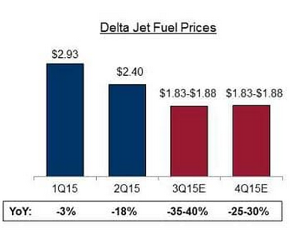
RyanAir (LONDON:RYA) is seeing such a positive impact that they were forced to pre-release earnings last week…
A combination of stronger than expected demand for flights over the summer, low fuel prices and higher fares has pushed Ryanair to raise its full year profit guidance by 25 percent. The European low cost airline, which has been trying to overhaul its image and attract more business passengers, has been forced to update shareholders early on its recent trading, after a much stronger than expected performance over the summer. Its decision to advise shareholders that profits are likely to be higher than forecast this year follows a similar move by its rival easyJet (LONDON:EZJ), which also recently reported unexpectedly high demand to beach destinations and European cities over the summer months…
Traffic in the first half of the year rose 13 percent compared to the company’s expectations of 10 per cent growth while fares were also 2 percent higher over the period. Ryanair had previously told shareholders that it expected no growth in fares amid intense competition in the European short haul market. In the third quarter, Ryanair is now expecting traffic growth of 15 percent compared to 13 percent previously and for fares to be flat whereas it had previously forecast a fall in ticket prices of between 4 and 8 percent during what is the traditionally quieter autumn and winter season, when airlines slash fares and often ground planes due to lower demand.
And we are finally seeing a significant uptick in petrochemical plant construction…
Natural gas is both raw material and fuel for petrochemical production, and the industry’s expansions have made the Houston area the birthplace of many products exported to China and the rest of the developing world. “Those of us who have been in this business for 30 years would never have imagined Texas and Houston to be the big export hub for petrochemicals,” Exxon Mobil (NYSE:XOM) Chemical President Neil Chapman said, noting that there had been little petrochemical growth in the region for at least 15 years.
The American Chemistry Council counts 243 announced projects with a cumulative investment of $147 billion from 2010 to 2023. More than 60 percent comes from foreign investment, and a small majority of projects remain in the planning stage. Global chemical demand is expected to double from 2000 to 2040 but stay flat in the U.S. Texas alone accounts for 99 of the projects with a total value of $48.2 billion, and most of those are in southern parts of Texas, including Houston, Corpus Christi and Beaumont. That means 15,800 direct new jobs in Texas – not counting construction jobs – and 67,000 nationwide, the council projects.
Not all will benefit from falling fuel prices. Fannie Mae is warning lenders about Energy job dependent economies…
Using oil-industry employment to gauge the potential drag on home values, the Fannie analysis finds that North Dakota faces the greatest possible hit on home values. If oil prices remain at the $55 a barrel over the next five years that is implied by the current price-futures curve, home prices in North Dakota could decline anywhere from 2% to 20% over the next five years, with an 11% decline as the base-case scenario. Wyoming could see declines of 4%, and Alaska, 8%. Texas, on the other hand, looks like it wouldn’t see any price declines. Under the base-case scenario, prices would rise 5% over five years—a far slower rate of growth, but growth nonetheless. Colorado, which was clobbered by the oil-patch recession, would see prices rise by 22% over the next five years.
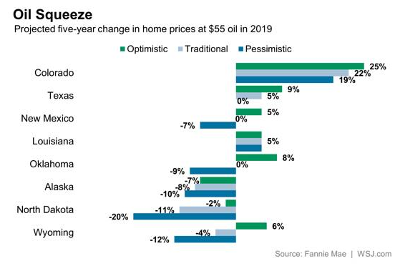
Back to Equities, some of the market’s newer technology stocks have had a volatile end to the summer…
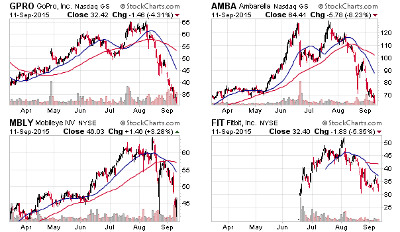
Last week in Japan, the market was volatile with an 8% gain in one day. But as Bespoke’s chart shows, 5%+ moves do not typically lead to higher prices; we would prefer to see a string of positive days rather than just one big moonshot day.
@bespokeinvest: Biggest rally for the Japan’s Nikkei in 4+ years. Here’s a chart showing occurrences of prior 5%+ up days since 2000.
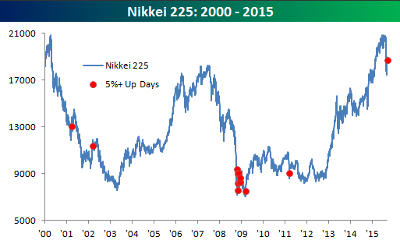
The recent market volatility has definitely impacted Main Street, as seen in the University of Michigan’s September survey…
“Compared with five years ago, do you think the chances that you (and your husband/wife) will have a comfortable retirement have gone up, gone down, or remained about the same?”
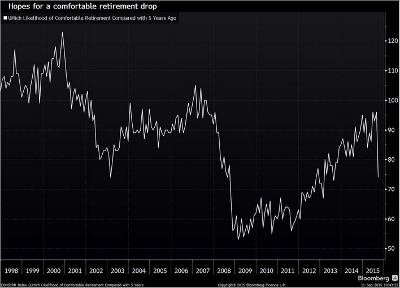
And volatility is causing investors to reduce exposure to Mutual Funds, as this Morningstar data for August shows; it is interesting to still see buyers of International Index Funds. We are of course happy to see the only actively managed category to grow assets in August was the Alternative category…
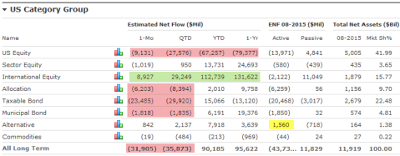
Some large Institutional Investors were also forced to reduce their Equity exposures if they were following a Risk Parity investing strategy…
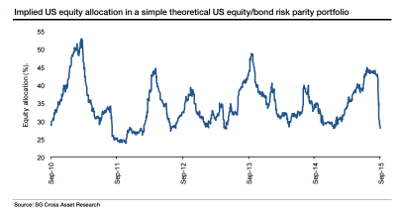
If you are forced to hunt for Equity exposure, these would be the areas that I would be spending the most time looking for: Stocks or ETFs…
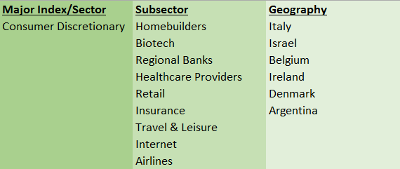
It is gut-check time for the Fiduciaries who were pulled into Emerging Market debt by the chase for yield…
The recent volatility in EM debt no doubt caused many to double fist Tequila and Maalox…
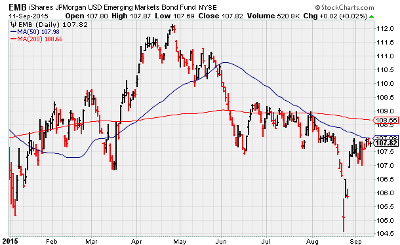
Fabulous timing by Petrobras in selling $2.5b of 100-year debt in June!
When Petroleo Brasileiro (NYSE:PBR) sold 100-year bonds in June, the move was largely seen as a sign the corruption-tainted oil producer had put the worst of its problems behind it… Since the $2.5 billion offering, the bonds have tumbled 15 percent. That’s four times the average loss for emerging-market company debt. The plunge deepened last week, when the securities sank to a record-low 69.5 cents on the dollar after Petrobras, as the Brazilian company is known, had its credit rating cut to junk by Standard & Poor’s. The world’s most-indebted major oil producer was stripped of its investment grade by Moody’s Investors Service seven months earlier as a widening probe into alleged bribes paid to former executives at the state-controlled oil company caused it to delay reporting earnings. Yields on Petrobras’s 6.85 percent bonds, which mature in 2115, have soared 1.5 percentage points to a record 9.86 percent since they were issued on June 2, according to data compiled by Bloomberg.
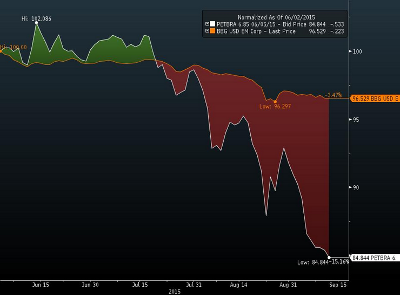
The information presented here is for informational purposes only, and this document is not to be construed as an offer to sell, or the solicitation of an offer to buy, securities. Some investments are not suitable for all investors, and there can be no assurance that any investment strategy will be successful. The hyperlinks included in this message provide direct access to other Internet resources, including Web sites. While we believe this information to be from reliable sources, 361 Capital is not responsible for the accuracy or content of information contained in these sites. Although we make every effort to ensure these links are accurate, up to date and relevant, we cannot take responsibility for pages maintained by external providers. The views expressed by these external providers on their own Web pages or on external sites they link to are not necessarily those of 361 Capital.
